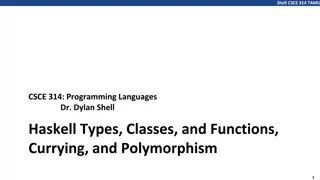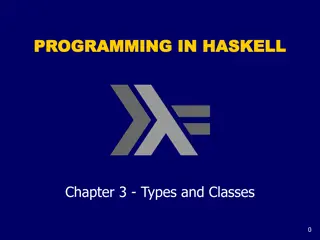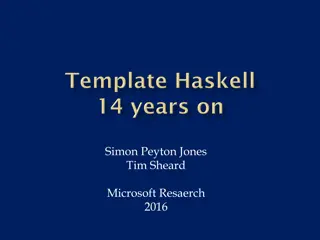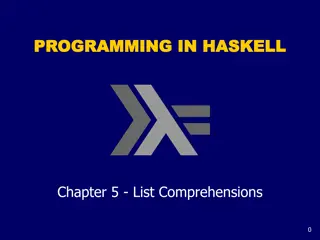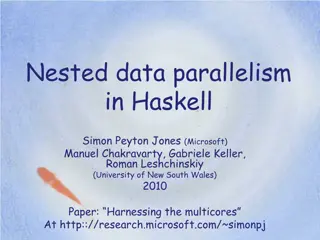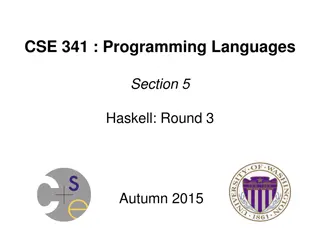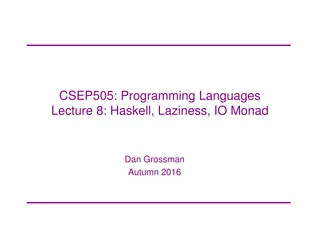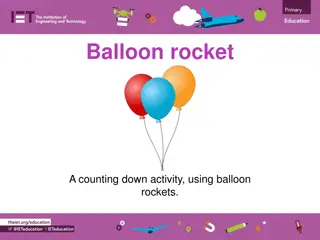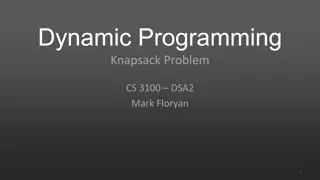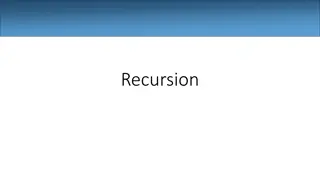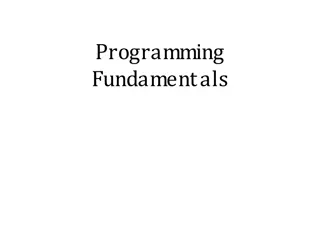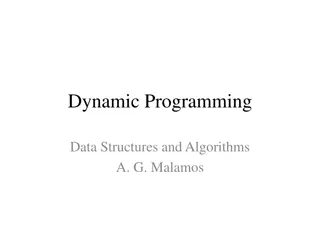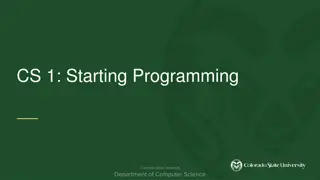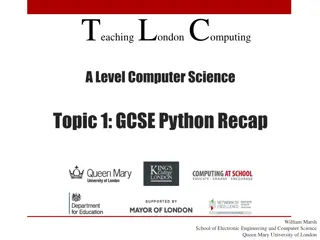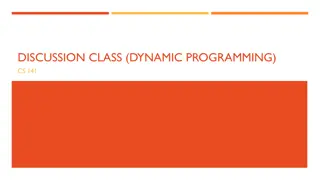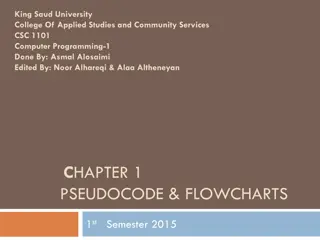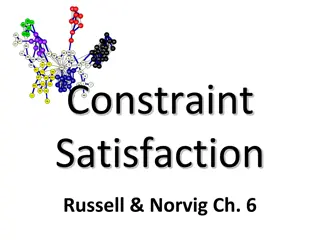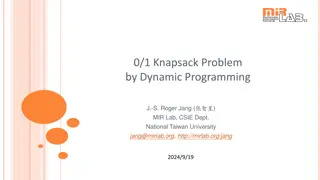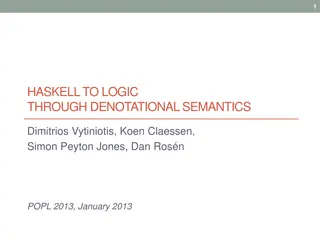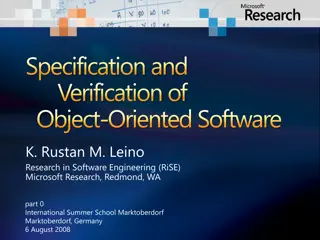The Countdown Problem in Haskell Programming
The Countdown problem, popularized by a British television quiz show, challenges players to use given numbers and arithmetic operators to reach a target number. This Haskell programming chapter explores evaluating expressions, applying operators, and formalizing the problem. Learn how to construct expressions and determine if the result is a positive natural number.
Download Presentation

Please find below an Image/Link to download the presentation.
The content on the website is provided AS IS for your information and personal use only. It may not be sold, licensed, or shared on other websites without obtaining consent from the author. Download presentation by click this link. If you encounter any issues during the download, it is possible that the publisher has removed the file from their server.
E N D
Presentation Transcript
PROGRAMMING IN HASKELL PROGRAMMING IN HASKELL Chapter 9 - The Countdown Problem 0
What Is Countdown? z A popular quiz programme on British television that has been running since 1982. z Based upon an original French version called "Des Chiffres et Des Lettres". z Includes a numbers game that we shall refer to as the countdown problem. 1
Example Using the numbers 1 3 7 10 25 50 and the arithmetic operators + - construct an expression whose value is 765 2
Rules z All the numbers, including intermediate results, must be positive naturals (1,2,3, ). z Each of the source numbers can be used at most once when constructing the expression. z We abstract from other rules that are adopted on television for pragmatic reasons. 3
For our example, one possible solution is = (25-10) (50+1) 765 Notes: z There are 780 solutions for this example. z Changing the target number to gives an example that has no solutions. 831 4
Evaluating Expressions Operators: data Op = Add | Sub | Mul | Div Apply an operator: apply :: Op Int Int Int apply Add x y = x + y apply Sub x y = x - y apply Mul x y = x * y apply Div x y = x `div` y 5
Decide if the result of applying an operator to two positive natural numbers is another such: valid :: Op Int Int Bool valid Add _ _ = True valid Sub x y = x > y valid Mul _ _ = True valid Div x y = x `mod` y == 0 Expressions: data Expr = Val Int | App Op Expr Expr 6
Return the overall value of an expression, provided that it is a positive natural number: eval :: Expr [Int] eval (Val n) = [n | n > 0] eval (App o l r) = [apply o x y | x eval l , y eval r , valid o x y] Either succeeds and returns a singleton list, or fails and returns the empty list. 7
Formalising The Problem Return a list of all possible ways of choosing zero or more elements from a list: choices :: [a] [[a]] For example: > choices [1,2] [[],[1],[2],[1,2],[2,1]] 8
Return a list of all the values in an expression: values :: Expr [Int] values (Val n) = [n] values (App _ l r) = values l ++ values r Decide if an expression is a solution for a given list of source numbers and a target number: solution :: Expr [Int] Int Bool solution e ns n = elem (values e) (choices ns) && eval e == [n] 9
Brute Force Solution Return a list of all possible ways of splitting a list into two non-empty parts: split :: [a] [([a],[a])] For example: > split [1,2,3,4] [([1],[2,3,4]),([1,2],[3,4]),([1,2,3],[4])] 10
Return a list of all possible expressions whose values are precisely a given list of numbers: exprs :: [Int] [Expr] exprs [] = [] exprs [n] = [Val n] exprs ns = [e | (ls,rs) split ns , l exprs ls , r exprs rs , e combine l r] The key function in this lecture. 11
Combine two expressions using each operator: combine :: Expr Expr [Expr] combine l r = [App o l r | o [Add,Sub,Mul,Div]] Return a list of all possible expressions that solve an instance of the countdown problem: solutions :: [Int] Int [Expr] solutions ns n = [e | ns' choices ns , e exprs ns' , eval e == [n]] 12
How Fast Is It? System: 2.8GHz Core 2 Duo, 4GB RAM Compiler: GHC version 7.10.2 Example: solutions [1,3,7,10,25,50] 765 One solution: 0.108 seconds All solutions: 12.224 seconds 13
Can We Do Better? z Many of the expressions that are considered will typically be invalid - fail to evaluate. z For our example, only around 5 million of the 33 million possible expressions are valid. z Combining generation with evaluation would allow earlier rejection of invalid expressions. 14
Fusing Two Functions Valid expressions and their values: type Result = (Expr,Int) We seek to define a function that fuses together the generation and evaluation of expressions: results :: [Int] [Result] results ns = [(e,n) | e exprs ns , n eval e] 15
This behaviour is achieved by defining results [] = [] results [n] = [(Val n,n) | n > 0] results ns = [res | (ls,rs) split ns , lx results ls , ry results rs , res combine' lx ry] where combine' :: Result Result [Result] 16
Combining results: combine (l,x) (r,y) = [(App o l r, apply o x y) | o [Add,Sub,Mul,Div] , valid o x y] New function that solves countdown problems: solutions' :: [Int] Int [Expr] solutions' ns n = [e | ns' choices ns , (e,m) results ns' , m == n] 17
How Fast Is It Now? Example: solutions' [1,3,7,10,25,50] 765 One solution: 0.014 seconds Around 10 times faster in both cases. All solutions: 1.312 seconds 18
Can We Do Better? z Many expressions will be essentially the same using simple arithmetic properties, such as: = x y y x = x 1 x z Exploiting such properties would considerably reduce the search and solution spaces. 19
Exploiting Properties Strengthening the valid predicate to take account of commutativity and identity properties: valid :: Op Int Int Bool x y valid Add x y = True valid Sub x y = x > y x y x y && x 1 x y && x 1 && y 1 valid Mul x y = True && y 1 valid Div x y = x `mod` y == 0 20
How Fast Is It Now? Example: solutions'' [1,3,7,10,25,50] 765 Around 20 times less. Valid: 250,000 expressions Around 16 times less. Solutions: 49 expressions 21
Around 2 times faster. One solution: 0.007 seconds Around 11 times faster. All solutions: 0.119 seconds More generally, our program usually returns all solutions in a fraction of a second, and is around 100 times faster that the original version. 22


